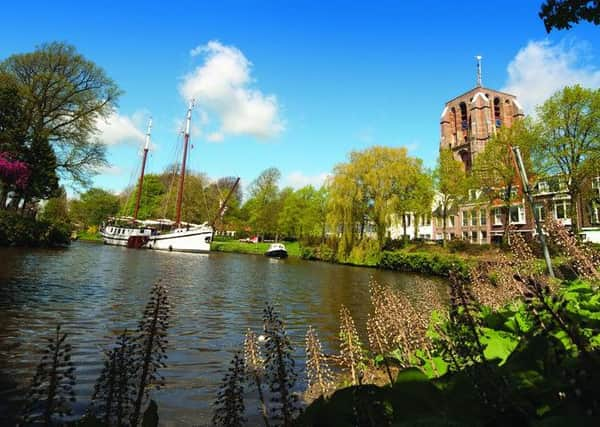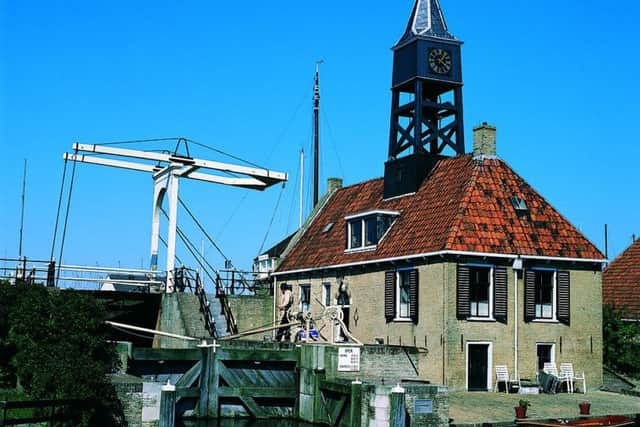Travel: A taste of home in the Netherlands


Near the northern edge of Europe, a once-independent country is famed for its wild coastline, for the cattle which roam its green fields, and for the excellent whisky brewed in its ancient towns. Quaint fishing villages freckle the coastline, interrupted by beaches whose pearlescent sands stand in stark contrast to the blustery North Sea beyond. Further inland, vibrant university cities testify to the mineral wealth unlocked offshore. An ancient local language is taught to children with pride, and the liberal, nautical culture often seems closer to Scandinavia than to the likes of England or Germany. Inevitably, some who inhabit this land have argued for independence. But for the Frisians of the northern Netherlands, the referendum never came.
Twenty thousand years ago, an enormous land bridge linked England and Scotland to the Netherlands. Woolly mammoths traversed the routes now plied by rumbling ferries, and a curious caveman could have walked from Aberdeen to Amsterdam without getting his feet wet. One mega-tsunami later, all that remains of the bridge is the Frisian Islands, a string of sandy islets curving around the northern Dutch coast. Barely an hour north of Amsterdam, the archipelago is unmistakably Dutch, but – along with the neighbouring mainland province of Friesland – retains a distinct culture, and an old-fashioned, independent streak which sets it apart from the increasingly globalised and touristy southern Netherlands.
Advertisement
Hide AdDutch friends had assured me that it was possible to reach the Frisian Islands on foot. Further research, however, revealed that doing so would involve a three-hour slog through thick mud reaching to my ankles if my guides were lucky with the tides, and above my waist if they were not. Pleading a lack of suitable clothing, I chose to travel the clean way: 20 minutes by ferry from Den Helder to Texel, a teardrop-shaped island about the size of Arran.


Texel is a popular holiday destination for Dutch families, and the harbour town of Den Hoorn included all the usual trappings of a Dutch seaside resort: fish and chip shops, chintzy bed-and-breakfasts, and noisy cafés serving hearty erwtensoep, or pea and ham soup. Outside the town, however, the island was pleasingly time-warped. I rented a bike and pedalled north through rolling sand dunes and past grassy fields of sheep, trying to glimpse the seals who lolled on sandbanks close to shore.
Some 400 years ago, Texel was a major maritime base, from where tall ships set out on expeditions to Asia, Africa and beyond – part of the great wave of Dutch exploration and trade which helped this tiny country become one of the richest in Europe. As the increasingly wealthy Dutch emerged onto world stage, the stormy seas off Texel were the setting for fierce sea battles between the Dutch and English fleets.
Today, few signs of the island’s illustrious naval past remained, but the beaches were among the most beautiful I’d ever seen. At De Cocksdorp, close to the northern tip of Texel, a red lighthouse stood sentry over a vast expanse of sand, as clean and white as snow. Across the channel, I could see the first of the half-dozen or so other islands nearby, each with a name liable to choke a non-Dutch speaker: Terschelling, Rottumeroog, Schiermonnikoog.
After a night in a B&B with a North Sea view, I returned by ferry to the mainland, keen to see more of Friesland proper. From Den Helder, the road led northeast over the Afsluitduik, perhaps the most impressive of the thousands of dikes and dams which lace the flood-prone Netherlands. Built in the 1930s, this 20-mile causeway had sealed the mouth of an enormous bay, converting the vast, stormy Zuider Zee (South Sea) into a placid inland lake. The Dutch have always had a love-hate relationship with the sea: it was the source of their prosperity, but also a constant threat. With more than a quarter of the country below sea level, authorities still face a Sisyphean task of building and maintaining defences which are constantly eroded by the waves. “‘God created the world,’ one local saying goes, “but the Dutch created the Netherlands.”
In Friesland, the results of their labours were clear. Land once several metres underwater was now rich pasture for the famous black-and-white Friesian cows. There wasn’t a hill to be seen, but this was undoubtedly one of the world’s geographical wonders: a perfect chessboard of arrow-straight canals and lush green fields, punctured by dozens of water-pumping windmills. Amidst the fields, I’d heard, lay several former islands – small towns once whipped by North Sea spray and dominated by the fishing trade, now isolated amid miles of reclaimed land. Gazing across the empty acres, it was easy to forget that I was in one of most crowded countries in the world.
Advertisement
Hide AdLeaving the coast behind, I looped inland through a series of unpronounceable towns steeped in Frisian lore – Franeker, Leeuwarden, Wolvega. Like much of Europe, the Netherlands has been somewhat battered in recent years by the tides of economic crisis, sparking an intense debate about how long the country’s famous tolerance can be maintained. In Frisian villages like Hindeloopen, though, little seemed to have changed in a century or more. Bicycles rattled over cobbled streets, market stalls sold waxy spherical cheeses, and ancient brick cottages looked out over tidy canals. Arguments about asylum seekers, marijuana and prostitution seemed a world away.
Within the Netherlands, Friesland is perhaps most famous for the Elfstedentocht, or Eleven-City-Tour, a legendary 150-mile ice skating race along the canals and rivers which link the northern cities. In a country where almost everyone owns a pair of skates, the tour is a major national event, and even a hint of frost is enough to send fans into a frenzy and fill Dutch television with ice-thickness forecasts. On a breezy summer day, there was little hope of skating, so I stopped at a little brown pub for a taste of the local whisky; Frysk Hynder single malt, brewed in the nearby town of Bolswaard. A cheerful blonde barmaid served me an icy, peaty glass and I raised it to her: “Proost!”, “Cheers!”
Advertisement
Hide AdThe tipple’s tongue-twisting name provided another clue to what made the region different. The local language, Fries, is a curious hybrid of Dutch and Old English, and spoken widely throughout the northern Netherlands. Friesland only joined with the rest of the country in the 1520s, and many in the region still harbour hopes of breaking free again. According to some nationalists, rich natural gas reserves could easily finance a Norwegian-style welfare state, were it not for greedy southerners and their high-spending ways. In 2004, the nationalists won a significant victory when the province’s official name changed from ‘Friesland’ to the more traditional ‘Fryslân’, although the former is still widely used. More recently, during last year’s Scottish vote, 18 members of the Frisian National Party travelled to Edinburgh to observe the ‘Yes’ campaign in action. “Perhaps we Frisians can learn something from such a referendum,” one nationalist councillor said.
In practice, given that the whole Netherlands is only about half the size of Scotland, Frisians have struggled to make the case for full independence, and most remain content to be ruled from afar. However, the Netherlands’ most northerly province remains a place apart. As I headed south for my home in Rotterdam, I felt privileged to have seen somewhere so traditional and yet so feisty, and to have had a taste of seafaring Europe as it once was, and might yet be.
• Ben Coates is the author of Why The Dutch Are Different: A Journey into the Hidden Heart of the Netherlands(Nicholas Brealey, £10.99 paperback), out now